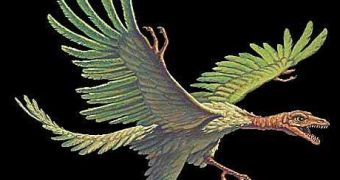Bird flight has fascinated humans since ever. And by over 150 years, with the discovery of the oldest bird, Archaeopteryx, a vivid debate divides scientists into two camps: those who say birds evolved from ground-dwelling ancestors and developed flight by taking off from the ground and those saying that birds evolved from tree-dwellers and flight first appeared by gliding from branches. Most fossils sustain the second theory.
Now the first camp comes with a new sustaining research. The trove of dinosaur fossils dug in the last 15 years has been coming with increased information of how early birds evolved 150 million years ago.
These feathered dinosaurs were on their way of turning into birds, they "had feathers, that were developing wings, that were forming beaks," said functional anatomist Christopher Glen at the University of Queensland in Australia, whose team research is published in the November 6th issue of Current Biology.
Glen's team first focused on toe claws from 249 species of modern birds, discovering that increased adaptation to tree life is correlated with more hooked claws, like in the case with woodpeckers, "as curved claws would provide them a better grip there," said Glen.
But when the team investigated the claws of the early birds and their closely-related bird-like dinosaur ancestors, it was found they all displayed the straighter claws of modern terrestrial birds, like turkeys, roadrunners and ostriches.
"I was actually expecting to find something different-I thought the 'trees-down' scenario made a lot of sense, with flight evolving as you had species jumping from tree to tree, gliding in between," Glen told LiveScience.
"The claws of Mesozoic birds and their immediate ancestors, the non-avian theropods, are relatively 'straight'-most like [those] of birds that are now either specialized for walking on the ground or have a preference for it, rather than the highly curved claws of birds that spend a lot of time in trees. We were particularly surprised by the fact that all the fossil species, representing evolutionary lineages from non-flying ancestors to early flying birds, had claws more like modern birds that spend most of their time on the ground." said Glen.
"Many modern birds do not live solely on the ground or in trees, but rather spent time doing both, suggesting the same might have been true of early birds. We're not saying we can resolve the entire story about bird flight just by looking at one feature of the anatomy. But their claws do suggest they spent more time on the ground." he added.
In fact, the team suggests that the assignment of living bird species as either ground- or tree-dwellers is loose as birds display various levels of ground- and tree-based behaviors, matching a continuum linked to the percentage of time accorded to ground foraging compared to tree foraging.
"In summary, since claw angle is independent of body size and the evolutionary relationships among species, it is a reliable indicator of the predominant behavior reliant upon hind-limb locomotion, and can make an important contribution to reconstructing the 'ecomorphology' of fossil species-how they lived and used their environments. Our findings suggest early birds foraged predominantly on the ground, rather than supporting previous suggestions of arboreal claw adaptations, which appear to have evolved later in the lineage." wrote the authors.
But many say that the claw clue is weak.
"Chickens can climb trees, but they have flat-footed claws. All these results wisely say is that the first birds had no obvious specializations of their claws [that are] characteristic of birds living in trees today," said evolutionary biologist Kevin Padian.

 14 DAY TRIAL //
14 DAY TRIAL //